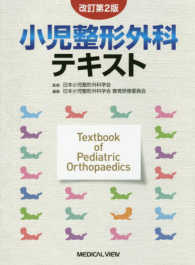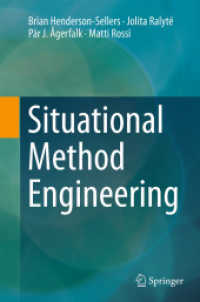- ホーム
- > 洋書
- > 英文書
- > Science / Mathematics
基本説明
Provides details of both conventional and modern molecular techniques applicable for the detection, identification, and differentiation of microbial pathogens.
Full Description
POSTHARVEST PATHOGENS AND DISEASE MANAGEMENT
Postharvest diseases caused by microbial pathogens account for millions of dollars in losses of both durable and perishable produce products every year. Moreover, with consumers increasingly demanding minimally processed vegetables and fruits--which can be invaded by human pathogens--there is an imperative need for suitable protective measures to provide pathogen-free commodities that are free from, or contain only acceptable levels of, chemical residues.
Providing details of both conventional and modern molecular techniques applicable for the detection, identification, and differentiation of field and storage microbial pathogens, Postharvest Pathogens and Disease Management:
* Discusses diseases of both durables and perishables during transit and storage
* Provides a basic understanding of the effects of handling and storage practices as well as field conditions and product susceptibility on the development of postharvest diseases
* Reveals, as a cautionary note, the potential hazards of mycotoxins with carcinogenic properties that can contaminate fruits and vegetables
* Contains detailed information derived from elucidative evidence and disease data in order to explain the infection process and subsequent stages of disease development
* Helps readers to avoid conditions that favor disease incidence and spread
* Includes real life examples of disease management strategies to help readers develop effective disease management systems suitable for different ecosystems
* Emphasizes the importance of integrating several different effective methods in tandem, including the development of cultivars with resistance to postharvest diseases; the selection of suitable analytical methods; and the effective use of biocontrol agents and chemicals
* Presents protocols for numerous techniques and basic methods, making the book a distinctive and highly useful teaching and research tool
Postharvest Pathogens and Disease Management offers readers insight into the principles and methods of avoiding and managing postharvest diseases of fruit and vegetable products in an efficient, economical, and environmentally feasible manner, allowing producers to sell safer, higher-quality produce to the public and prevent the losses associated with postharvest disease.
Contents
Preface. Acknowledgments.
PART I: CAUSES AND EFFECTS.
1. Introduction.
1.1 Importance of postharvest diseases.
1.2 Factors favoring development of postharvest diseases.
1.3 Development of disease management strategies.
Summary.
References.
2. Detection and Identification of Postharvest Microbial Pathogens.
2.1 Microbial pathogens in seeds.
2.2 Microbial pathogens in propagative plant materials.
2.3 Microbial pathogens in fruits.
2.4 Microbial pathogens in vegetables.
Summary.
Appendix.
References.
3. Ecology of Postharvest Microbial Plant Pathogens.
3.1 Seed microflora.
3.2 Fruit microflora.
3.3 Vegetable microflora.
Summary.
References.
4. Disease Development and Symptom Expression.
4.1 Seed infection.
4.2 Seed deterioration.
4.3 Infection of fruits and vegetables.
Summary.
Appendix.
References.
PART II: FACTORS INFLUENCING DISEASE DEVELOPMENT IN STORAGE.
5. Influence of Cultivation Practices and Harvesting Methods.
5.1 Cultivation practices.
5.2 Harvest-related operations.
Summary.
References.
6. Influence of Postharvest Handling and Storage Conditions.
6.1 Postharvest handling.
6.2 Storage conditions.
Summary.
References.
PART III: PRINCIPLES AND PRACTICES OF POSTHARVEST DISEASE MANAGEMENT.
7. Preventive and Physical Methods of Disease Management.
7.1 Seeds and propagative materials.
7.2 Fruits and vegetables.
Summary.
References.
8. Genetic Resistance of Host Plants for Disease Management.
8.1 Molecular biology of host plant resistance.
8.2 Resistance to seed infection.
8.3 Development of disease resistant cultivars.
Summary.
Appendix.
References.
9. Biocontrol Agents for Disease Management.
9.1 Biological control of postharvest diseases of fruits.
9.2 Biological control of postharvest diseases of vegetables.
9.3 Biocontrol of seed spoilage.
9.4 Mechanisms of biocontrol.
9.5 Enhancement of efficiency of biocontrol agents.
9.6 Formulation of biocontrol agents.
9.7 Natural compounds.
Summary.
Appendix.
References.
10. Biotechnology for Improvement of Resistance to Postharvest Diseases.
10.1 Genetic manipulation.
10.2 Activation of natural host defense mechanisms.
10.3 Mycotoxin management through transformation.
Summary.
Appendix.
References.
11. Postharvest Disease Management through Chemicals.
11.1 Fumigants.
11.2 Chemicals used as dips.
11.3 Chemicals applied as sprays or dusts.
11.4 Assessment of fungicidal activity.
11.5 Chemicals as alternative to fungicides.
11.6 Seed treatment with chemicals.
11.7 Development of resistance to fungicides.
11.8 Assessment of fungicide residues.
11.9 Control of fresh-cut produce-borne pathogens.
Summary.
Appendix.
References.
12. Integrated Systems of Management of Postharvest Diseases.
12.1 Seedborne diseases.
12.2 Postharvest diseases of perishables.
Summary.
References.
Addendum: Basic Methods .
References.
Index.








